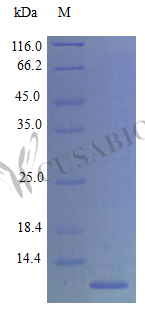Recombinant Mouse Eotaxin protein (Ccl11) is expressed in E. coli and represents the full length of the mature protein, covering the 24-97 amino acid region. This tag-free protein achieves a purity level exceeding 96%, as confirmed by SDS-PAGE analysis. It appears to be fully biologically active, with chemotaxis bioassays demonstrating activity in the 100-1000 ng/ml range with purified eosinophils. The endotoxin level is maintained below 1.0 EU/µg, as measured by the Limulus Amebocyte Lysate (LAL) method.
Eotaxin is a chemokine primarily involved in recruiting eosinophils—a type of white blood cell implicated in allergic reactions and asthma. It plays what appears to be a crucial role in the inflammatory response by guiding eosinophils to sites of inflammation. The protein's activity is essential for studying eosinophil behavior. It may also help researchers explore therapeutic strategies targeting eosinophilic inflammation in various research settings.
Potential Applications
Note: The applications listed below are based on what we know about this protein's biological functions, published research, and experience from experts in the field. However, we haven't fully tested all of these applications ourselves yet. We'd recommend running some preliminary tests first to make sure they work for your specific research goals.
1. Eosinophil Chemotaxis Assays
This recombinant mouse eotaxin (Ccl11) protein is confirmed to be biologically active in eosinophil chemotaxis assays (active at 100-1000 ng/ml) and suitable as a positive control. However, the relatively high concentration range suggests moderate potency compared to some chemokines. Researchers should perform careful dose optimization for their specific eosinophil sources and assay conditions. The high purity (>96%) and low endotoxin levels support reliable results, but the wide activity range indicates variable sensitivity across different eosinophil preparations.
2. Receptor Binding and Interaction Studies
The biologically active eotaxin is appropriate for CCR3 receptor binding studies, but the high effective concentration range may indicate moderate receptor affinity. Binding assays should be designed with appropriate concentration ranges to accurately determine kinetic parameters. The tag-free design ensures authentic interactions, but researchers should validate that binding characteristics align with functional activity in chemotaxis assays.
3. Antibody Development and Validation
This high-purity eotaxin serves as a good antigen for antibody development. The confirmed biological activity indicates proper folding for conformational epitopes. However, antibodies should be validated against native mouse eotaxin from biological sources to ensure recognition of physiologically relevant forms, as E. coli expression lacks mammalian post-translational modifications that may affect some epitopes.
4. In Vitro Inflammatory Response Modeling
The protein can be used in inflammatory models, but the high working concentrations (up to 1000 ng/ml) may cause non-specific effects in complex co-culture systems. Researchers should include appropriate controls to distinguish specific eotaxin-mediated effects from potential non-specific stimulation at higher concentrations. Dose-response relationships should be carefully established for each cell type in co-culture experiments.
5. Pharmacological Screening Assays
This eotaxin is suitable for screening assays, but the wide activity range and moderate potency may challenge high-throughput screening formats. The consistent biological activity supports reproducibility, but screening campaigns should include robust controls for compound interference and validate hits in secondary assays with full dose-response curves. The high purity minimizes false positives from contaminants.
Final Recommendation & Action Plan
This recombinant mouse eotaxin (Ccl11) is a validated tool for studying eosinophil biology, though its relatively high effective concentration range (100-1000 ng/ml) indicates moderate potency compared to some chemokines. For immediate use, perform careful dose optimization in each specific assay system, as eosinophil sensitivity may vary by source and activation state. The high purity and low endotoxin make it suitable for sensitive cell-based assays, but researchers should include appropriate controls at higher concentrations to account for potential non-specific effects. When developing antibodies, validate against native eotaxin from inflammatory models to ensure biological relevance. For screening applications, the wide activity range requires robust assay validation and hit confirmation with full concentration responses. While the E. coli expression produces a non-glycosylated protein, the demonstrated bioactivity confirms proper folding for CCR3 engagement and chemotactic function. Always include proper controls and consider that different eosinophil preparations may exhibit varying sensitivity to eotaxin stimulation.






